Australia Container Glass Market Size
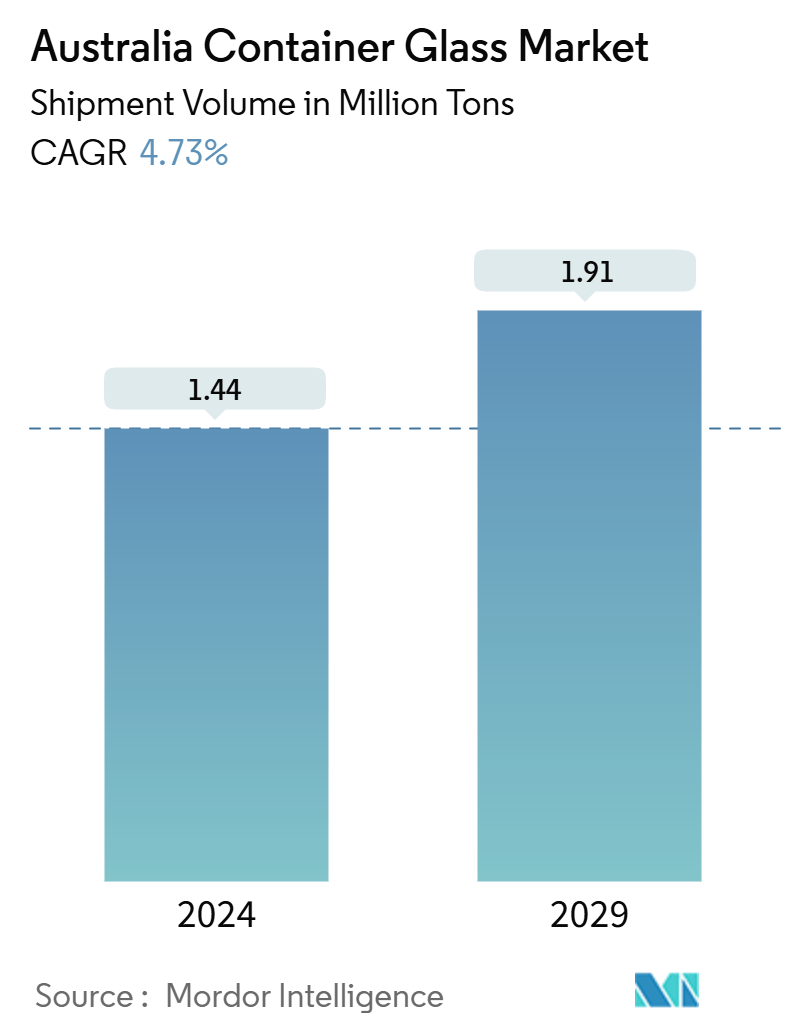
| Study Period | 2019 - 2029 |
| Base Year For Estimation | 2023 |
| Market Volume (2024) | 1.44 Million tons |
| Market Volume (2029) | 1.91 Million tons |
| CAGR (2024 - 2029) | 4.73 % |
| Market Concentration | High |
Major Players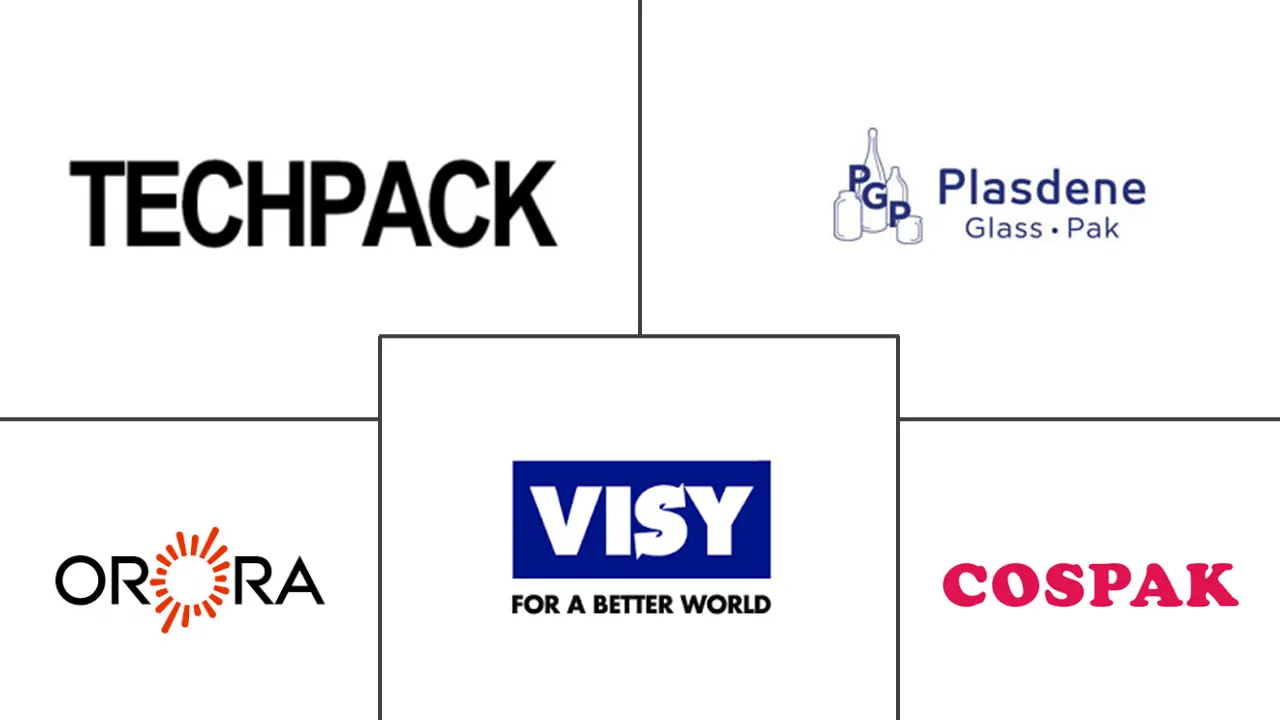
*Disclaimer: Major Players sorted in no particular order |
Australia Container Glass Market Analysis
The Australia Container Glass Market size in terms of shipment volume is expected to grow from 1.44 Million tons in 2024 to 1.91 Million tons by 2029, at a CAGR of 4.73% during the forecast period (2024-2029).
In Australia, the container glass market is on a steady upward trajectory. This growth is fueled by a confluence of trends: a heightened focus on environmental sustainability, changing consumer preferences, and the weight of regulatory influences.
- The push for sustainable packaging materials has gained momentum, with consumers and businesses keen on minimizing their environmental footprint. With its inherent recyclability and reusability, Glass fits seamlessly into this sustainability narrative, leading to its broader acceptance across diverse sectors.
- Moreover, government regulations championing sustainable practices bolster this momentum, particularly as Australia aims to align with global environmental commitments, notably the United Nations Sustainable Development Goals (SDGs).
- Australia is a prominent player in the global wine production arena, leading to a predominant choice of glass bottles for domestic and international wine brands. Furthermore, heightened consumer awareness about health and food safety has elevated the status of glass packaging, highlighting its safety and absence of harmful chemicals, such as BPA, commonly associated with plastics.
- Moreover, the incorporation of recycled glass, or cullet, into production lines is gaining traction, as it markedly diminishes energy consumption during manufacturing. This trend resonates with Australia's commitment to circular economy principles, with an increasing number of companies aiming to lessen their environmental impact by boosting the recycled content in their glass products.
- Despite its growth, the market grapples with challenges, notably the substantial energy demands and carbon emissions tied to glass production. As energy prices surge and environmental concerns mount, manufacturers are channeling investments into energy-efficient processes and renewable energy sources to curb emissions.
Australia Container Glass Market Trends
Alcoholic Beverage is Expected to Account For Significant Market Share
- The alcoholic beverage segment commands a leading position. A rising volume of alcohol consumption and evolving consumer preferences primarily drive this dominance. Australia's vibrant wine, beer, and spirits sectors heavily depend on glass packaging.
- This preference is due to glass's unique ability to preserve flavour, uphold product quality, and impart a premium aesthetic—attributes especially vital for wine and upscale spirits, which are particularly sensitive to their packaging materials.
- Craft beers and artisanal ciders have surged in popularity, fueled by consumers' desires for distinctive flavours and local offerings. A notable trend is the shift towards premium and super-premium alcoholic beverages, underscoring consumers' readiness to invest in superior quality. Additionally, there's an escalating interest in sustainable production, with many consumers actively pursuing organic and eco-friendly choices.
- According to data from the Australian Institute of Health and Welfare, alcohol consumption in Australia rose in 2022-23. A total of 225.4 million litres of pure alcohol were available for consumption, marking an 8.1% increase from the 208.6 million litres recorded in 2019-20. Per capita consumption also rose, climbing from 10.0 litres in 2019-20 to 10.5 litres in 2022-23. This uptick translates to roughly four additional bottles of red wine per person annually in Australia.
- Beyond catering to domestic consumers, the export market is pivotal in driving Australia's demand for glass packaging. Renowned for their quality and diversity, Australian wines constitute a substantial portion of the nation's exports. Glass bottles serve a dual purpose: they safeguard these beverages over long transport distances and resonate with global trends favouring sustainable and premium packaging, making them attractive to international buyers.
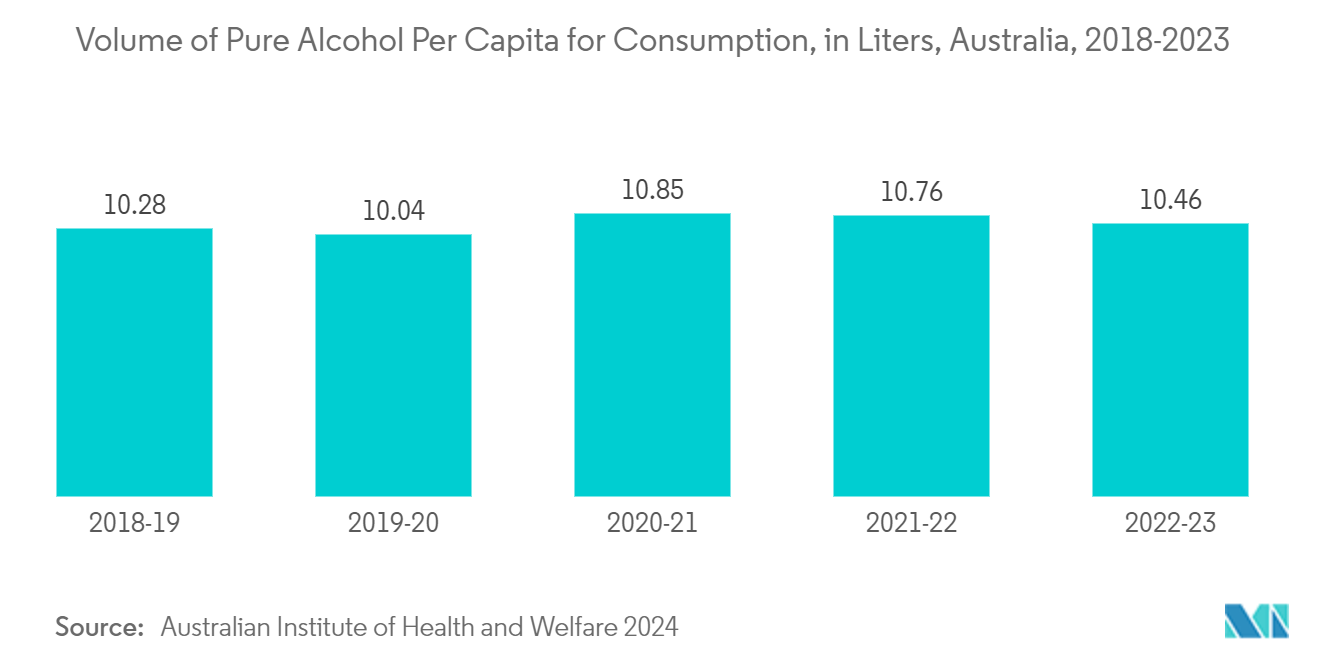
Increasing Emphasis on Glass Recycling and Recyclability Rate in the Country
- Both industry initiatives and government regulations focused on reducing environmental impact are driving a heightened emphasis on recycling rates. In Australia, glass recycling has surged in popularity, with stakeholders across the supply chain, from manufacturers to consumers, acknowledging the advantages of a closed-loop system.
- Recycling glass curtails the demand for raw materials, slashes energy consumption, and curtails greenhouse gas emissions tied to glass production. The environmental advantages are pronounced: incorporating recycled glass, or cullet, in manufacturing can lead to a 30% reduction in energy consumption compared to virgin materials.
- Furthermore, container glass is the primary packaging for several end-user industries, including pharmaceuticals and cosmetics. Data from the Australian Bureau of Statistics reveals that the annual revenue for retail pharmaceuticals, cosmetics, and toiletry goods in Australia was AUD 13.63 billion in 2020 (USD 9.05 billion), with projections reaching AUD 21.93 billion (USD 14.56 billion) by 2024. This revenue growth underscores the rising demand in the container glass market, and as this demand escalates, so does the imperative for recycling.
- Federal and state governments enact policies and programs to enhance recycling rates and minimize landfill waste. Container Deposit Schemes (CDS), now operational in most Australian states, have effectively motivated consumers to recycle glass bottles and other packaging. These schemes foster a more sustainable waste management cycle by offering modest financial incentives for returned glass containers.
- For instance, New South Wales and Victoria have successfully diminished glass waste and bolstered collection rates through their CDS initiatives. Beyond environmental benefits, these efforts ensure a consistent supply of recycled glass for manufacturers, furthering the integration of cullet in production processes.
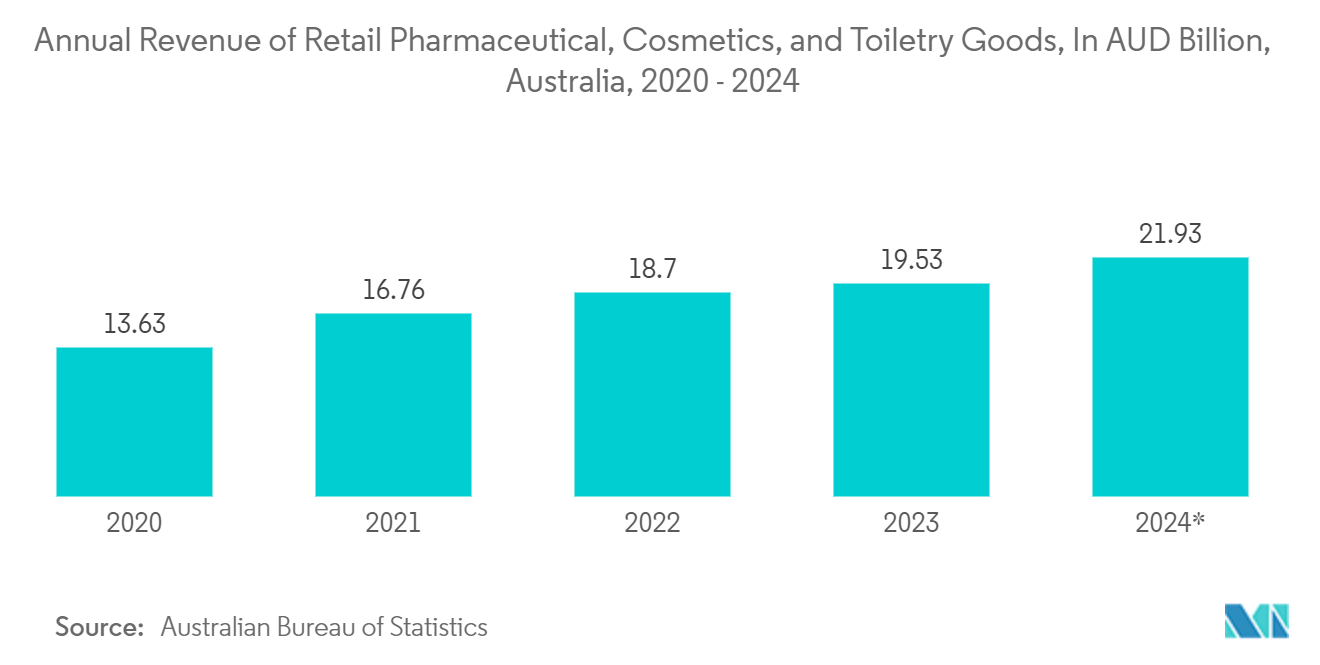
Australia Container Glass Industry Overview
Australia Container Glass market is consolidated with manufacturers such as Visys Group, Orora Packaging Australia Pty Ltd and leading suppliers includes Cospak (SMYC Pty Ltd), Plasdene Glass-Pak Pty Ltd, Techpack Pty Ltd among others. These major players are vying for higher market share in the Australian market by implementing strategies such as mergers & acquisitions, product innovation, and expansion to grow in the market.
Australia Container Glass Market Leaders
-
Visy Group
-
Orora Packaging Australia Pty Ltd
-
Cospak (SMYC Pty Ltd)
-
Plasdene Glass-Pak Pty Ltd
-
Techpack Pty Ltd
*Disclaimer: Major Players sorted in no particular order
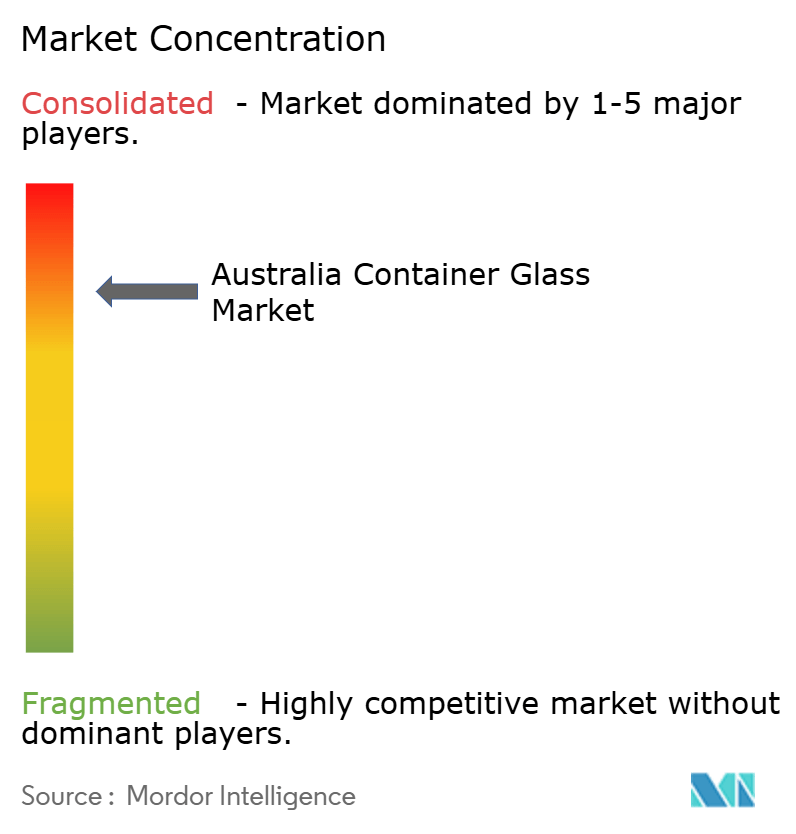
Australia Container Glass Market News
- July 2024: Visy, the largest recycling company in Australia, launched the nation's inaugural oxygen-fuelled glass furnace at its facility in Penrith, located in Western Sydney. Notably, Visy’s Penrith site stands as New South Wales' sole manufacturer of glass bottles and jars, churning out over 800 million glass containers annually. These containers cater to prominent Australian food and beverage brands, including Vegemite, Cottee’s Jam, Toohey's New, and Bundaberg Ginger Beer. Utilizing cutting-edge recycled cullet pre-heating technology, the facility aims to boost the incorporation of recycled glass in Australia's glass bottle manufacturing industry.
- December 2023: Orora finalized its acquisition of Saverglass, officially integrating the premium global glass business into the Orora Group. As a prominent manufacturer and distributor of sustainable and innovative packaging solutions worldwide, this acquisition not only signifies a pivotal moment for both entities but also positions Orora as a formidable player in the lucrative premium beverage market on a global scale.
Australia Container Glass Market Report - Table of Contents
1. INTRODUCTION
1.1 Study Assumptions and Market Definition
1.2 Scope of the Study
2. RESEARCH METHODOLOGY
3. EXECUTIVE SUMMARY
4. MARKET INSIGHTS
4.1 Market Overview
4.2 PESTEL Analysis - Container Glass Industry in Australia
4.3 Industry Standards and Regulations for Container Glass for Packaging
4.4 Raw Material Analysis & Material Considerations for Packaging
4.5 Sustainability Trends for Packaging
4.6 Container Glass Furnace Capacity and Location in Australia
5. MARKET DYNAMICS
5.1 Market Drivers
5.1.1 Increasing Production of Beverages in the Country
5.1.2 Increasing Glass Recycling Rate and Investment in New Recyling Facilities
5.2 Market Restraints
5.2.1 Availablity of the Substitute materials can Hinder the Growth of the Market
5.3 Trade Scenario - Analysis of the Historical and Current Export-Import Paradigm for the Container Glass Industry in Australia
6. MARKET SEGMENTATION
6.1 End-user Industry
6.1.1 Beverage
6.1.1.1 Alcoholic Beverages (Qualitative Analysis to be Provided)
6.1.1.1.1 Wines and Spirits
6.1.1.1.2 Beer and Cider
6.1.1.2 Non-Alcoholic Beverages (Qualitative Analysis to be Provided)
6.1.1.2.1 Carbonated Soft Drinks
6.1.1.2.2 Juices and Flavored Drinks
6.1.1.2.3 Water
6.1.2 Food
6.1.3 Cosmetics
6.1.4 Pharmaceuticals
6.1.5 Other End user verticals
7. COMPETITIVE LANDSCAPE
7.1 Company Profiles
7.1.1 Visy Group
7.1.2 Orora Packaging Australia Pty Ltd
- *List Not Exhaustive
8. LIST OF SUPPLIERS
8.1 Cospak (SMYC Pty Ltd)
8.2 Plasdene Glass-Pak Pty Ltd
8.3 Centaur Packaging
8.4 Austrapak Jars and Bottles
8.5 Techpack Pty Ltd
9. SUPPLEMENTARY COVERAGE - ANALYSIS OF MAJOR FURNACE SUPPLIERS TO CONTAINER GLASS PLANTS IN AUSTRALIA
10. FUTURE OUTLOOK OF THE MARKET
Australia Container Glass Industry Segmentation
Container glass is designed for crafting glass containers, including bottles, jars, drinkware, and bowls. Its key attributes include chemical inertness, sterility, and non-permeability, rendering it especially sought after in the beverage, food, pharmaceutical, and cosmetic sectors. The research also examines underlying growth influencers and significant industry vendors, all of which help to support market estimates and growth rates throughout the anticipated period. The market estimates and projections are based on the base year factors and arrived at top-down and bottom-up approaches.
Australia Container Glass Market is Segmented by End-User Industry ((Beverages (Alcoholic Beverages (Wines and Spirits, Beer and Cider) and Non-Alcoholic Beverages (Carbonated Soft Drinks, Juices and Flavored Drinks, Water), Food, Cosmetics, Pharmaceutical, and Other End-User Industries). The Market Sizes and Forecasts are Provided in Terms of Volume (Tonnes) for all the Above Segments
| End-user Industry | |||||||||||
| |||||||||||
| Food | |||||||||||
| Cosmetics | |||||||||||
| Pharmaceuticals | |||||||||||
| Other End user verticals |
Australia Container Glass Market Research Faqs
How big is the Australia Container Glass Market?
The Australia Container Glass Market size is expected to reach 1.44 million tons in 2024 and grow at a CAGR of 4.73% to reach 1.91 million tons by 2029.
What is the current Australia Container Glass Market size?
In 2024, the Australia Container Glass Market size is expected to reach 1.44 million tons.
Who are the key players in Australia Container Glass Market?
Visy Group, Orora Packaging Australia Pty Ltd, Cospak (SMYC Pty Ltd), Plasdene Glass-Pak Pty Ltd and Techpack Pty Ltd are the major companies operating in the Australia Container Glass Market.
What years does this Australia Container Glass Market cover, and what was the market size in 2023?
In 2023, the Australia Container Glass Market size was estimated at 1.37 million tons. The report covers the Australia Container Glass Market historical market size for years: 2019, 2020, 2021, 2022 and 2023. The report also forecasts the Australia Container Glass Market size for years: 2024, 2025, 2026, 2027, 2028 and 2029.
Australia Container Glass Industry Report
Statistics for the 2024 Australia Container Glass market share, size and revenue growth rate, created by Mordor Intelligence™ Industry Reports. Australia Container Glass analysis includes a market forecast outlook for 2024 to 2029 and historical overview. Get a sample of this industry analysis as a free report PDF download.



